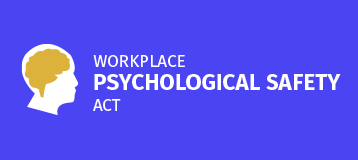The Workplace Psychological Safety Act addresses a psychological abuse issue rooted in the social problem of discrimination, a reinforcement of the social hierarchy.
Employers reinforce the hierarchy with such tactics as:
- Keeping wages low
- Failing to conduct investigations for reports of mistreatment
- Silencing workers through non-disclosure agreements
- Pushing workers out of their jobs for any reason or no reason at all
- Paying tipped workers sub minimum wages
- Asking workers their salary history or desired salary range
- Conducting abusive scheduling practices for hourly workers
- Stealing wages or punishing injured workers with no consequence
- Asking workers to sign away their rights through abusive waivers, and
- Tying health care to work so workers have more to lose by leaving a toxic workplace.
These tactics keep workers at the mercy of employers and trapped in submission. Meanwhile, deindustrialization, fewer unions, and an increase in the number of corporate lobbyists result in increased corporate power to maintain barriers (Desmond, 2023).
CONSTRUCTIONS OF THE PROBLEM
Employers use false narratives and sabotage to reinforce the hierarchy, justifying their privileged power by assigning negative stereotypes to non-privileged groups and maintaining their own positive stereotypes. These constructions are rooted in social dominance orientation ideology involving the belief and tolerance of hierarchy in society (Waldfogel et al., 2021) and use victim-blaming of those in groups that threaten their power to maintain social inequality and dominance of the privileged group: those in power.
Projection, attributing unacceptable feelings onto another, can explain this tactic. Those in power who reinforce stereotypes push onto workers their negative feelings such as guilt and shame associated with emotions, poor work ethic, and incompetence to control these negative parts of the self, now outside of themselves, without having to confront these struggles internally. Victim-blaming renders toxic policies and practices invisible to maintain power, and the tactic has worked. In late 2022, “68.2 percent of the total wealth in the United States was owned by the top 10 percent of earners. In comparison, the lowest 50 percent of earners only owned three percent of the total wealth” (U.S. wealth distribution 2022, 2023). With “quintuple [$511,000] the median net worth of the American household” in 2018, federal lawmakers fell into the affluent category (Hawkings, 2018).
THE EXTENT OF THE PROBLEM
The discrimination problem is both stagnant and widespread. Researchers’ estimates show discrimination has remained relatively constant over time, with little evidence it has diminished over time, indicating a problem with anti-discrimination law:
- Stagnant. Data from 2013 shows white men are significantly overrepresented in management positions, and every other group is underrepresented, the same as 1966 when the EEOC started collecting data on the race and gender composition of workplaces.
- Widespread. The number of employment discrimination filings doubled in the 1990s, from 10,000 in 1991 to 23,735 in 1998, decreasing to 13,831 in 2014, with race and gender topping the reasons for lawsuits (Berrey et al., 2023). But only a small percentage of targets file legal claims. “About four-in-ten working women (42 percent) in the United States say they have faced discrimination on the job because of their gender” and “about one in four Black (24 percent) and Hispanic employees (24 percent) in the U.S. report having been discriminated against at work in the past year” (Parker & Funk, 2020; Lloyd, 2022).
At the same time, CEOs, landlords, and banks have shown staggering greed:
- CEO pay. In 2021, CEO pay increased by 1,460 percent since 1978 and is now 399 times as much as a typical worker (Bivens & Kandra, 2022).
- Unlivable wages. Yet families below the poverty threshold ($27,750 for a family of four in 2022) on average earn $76,327 below the living wage ($104,077 for a family of four in 2022) to cover such basic needs as food, childcare, transportation, housing, and health care (Bivens & Kandra, 2022; Living wage calculator, 2023).
- Rent hikes. Renter households with the lowest incomes both spent a larger share of income on rent in 2021 and experienced the largest rental increases by percentage (Mateyka & Yoo, 2023).
- Bank fees. Bank fees hurt low-income households, especially Hispanic and Black households, who paid $3.1 billion and $1.4 billion respectively in overdraft fees and $1.1 billion and $800 million respectively in checking account maintenance fees, money orders, and check cashing in 2020 (Brooks, 2021).
At the same time, deindustrialization, fewer unions, and an increase in the number of corporate lobbyists resulted in increased corporate power (Desmond, 2023):
- Deindustrialization. Deindustrialization from corporate mergers resulted in millions of U.S. workers losing high-paying jobs (Encyclopedia.com, 2023).
- Unions. In the last 40 years, union membership for collective employee action has fallen by 10 percent, from 20.1 percent of all U.S. workers in 1983 to 10.1 percent in 2022 (Green, 2023).
- Corporate lobbying. The number of registered lobbyists, 12,644 in 2022, increased by more than 1,000 in the last two years, and the amount corporations spent on lobbying, $4.09 billion in 2022, increased by about a half billion dollars in the same timeframe (Total lobbyists U.S. 2022, 2023; Total lobbying spending U.S. 2022, 2023).
WHO IS NEGATIVELY AFFECTED BY THE PROBLEM AND HOW
There is a discriminatory impact of the social hierarchy on non-wealthy Americans:
- Pain. Pain, worry, sadness, and anger are significantly lower among the wealthy.
- Happiness. Life satisfaction is significantly higher among the wealthy.
- Stress. Those in lower rungs on the social hierarchy endure stress with reduced opportunity long-term due to discriminatory practices in health care access, education, getting a loan, and buying a home. They also suffer from stress with such crises as a sick child, car problems, or a health problem pushing them into a financial catastrophe without a cushion, leading to chronic stress often resulting in heart disease, stroke, anxiety, depression, and low birth weight that sets children up for lifelong disadvantages (Mayo Foundation for Medical Education and Research, 2021; Graham, 2015). These health disparities have a discriminatory impact on Black and Hispanic Americans, with 13.8 percent of African Americans and 10 percent of Hispanic Americans reporting fair or poor health compared with 8.3 percent of non-Hispanic whites in 2018 (Carratala & Maxwell, 2020).
Those in power benefit from maintaining a social order to maintain power and earn money from those on lower rungs of the hierarchy, reinforcing the social dominance orientation ideology in addition to white supremacy and patriarchal ideologies based on discriminatory impact. Maintaining wealth as a form of social power and reinforcing a hierarchy wards off economic threats and ensures oppression of those threats (Manstead, 2018).
Those in power maintain social power not only through control of workplaces, housing, and banking but also through generational wealth, which maintains the social hierarchy and ensures the intergenerational standing of certain groups (Barusch, 2018). “The typical White family has eight times the wealth [median of $188,200 in 2019] of the typical Black family [median of $24,100 in 2019] and five times the wealth of the typical Hispanic family [median of $36,100 in 2019]” (Bhutta et al., 2023). Wealth builds from interest on and investment in previous wealth, reinforced in the social hierarchy when other groups are unable to accumulate wealth (McKay, 2022).
THE WORKPLACE PSYCHOLOGICAL SAFETY ACT
For the estimated 48.6 million Americans affected by workplace psychological abuse according to a 2021 Workplace Bullying Institute study, the Workplace Psychological Safety Act addresses a psychological abuse issue, part of a discrimination issue. End Workplace Abuse defines workplace psychological abuse as bullying and mobbing that violate an employee’s inherent basic human right to dignity and create a toxic work environment deemed by a reasonable person. Advocates drafted this bill to propose stronger protections than other workplace anti-abuse legislation with a focus on prevention and employer accountability to move the needle on safer workplaces.
Other legislation calls for proof of intent and health harm: two factors eliminated with sexual harassment law in the 1980s and 1990s:
- Intent is too high a threshold to impact employers, especially when sexual harassment does not require proof of intent.
- Health harm should not have to be suffered to hold employers accountable for toxic behaviors, especially when sexual harassment law does not require psychological injury. In addition, employers pay physicians to evaluate workers who file discrimination complaints and then point to any cause but the workplace abuse as the reason for the health harm.
Employers have historically found loopholes to work around worker protections, showing a need for strong protections. The Workplace Psychological Safety Act eliminates proof of intent and health harm, instead focusing on specific common behaviors to give stronger protections to people of color, women, workers with disabilities, workers over 40, and workers in the LGBT+ community while protecting those in other groups who suffer from similar toxic behaviors. The bill also calls for addressing this issue both as a set of individual cases and a symptom of systemic discrimination by requiring employers to report on signs of workplace culture health and worker well-being: stress leave rates, mistreatment reporting rates, attrition rates, and more.
THE GOAL AND RATIONALE
The goal of the Workplace Psychological Safety Act is to both give marginalized workers and all workers a path to justice and validation of social values and to hold employers and abusers accountable for toxic behavior and negligence in addressing the issue through rigged internal protocol. The rationale for the bill is rooted in the value of morality: a belief that humans have worth and therefore have a right to psychological safety as a basic right under a human rights ideology.
SUPPORT FOR THE LEGISLATION
Sitting against a backdrop of #MeToo and Black Lives Matter, two campaigns that exposed hidden epidemics of abuse around identity, workplace anti-abuse legislation has gained attention from labor, identity, progressive, and religious groups. The bill has gained bipartisan support and has especially been backed by progressive groups whose members support other workers’ rights bills.
Multiple workers’ rights advocates report taking 20 years to pass bills, and with 10 years of this issue in multiple state legislatures, we may be halfway to our goal of passing strong protections in one state to begin a domino effect of passing protections in other states.
End Workplace Abuse strategized introducing the Workplace Psychological Safety Act in more progressive states with stronger workers’ rights bills to create momentum with movement-building, with the ultimate goal of making “workplace abuse” a household term, much like domestic abuse.
BENEFITS OF PASSING THE WORKPLACE PSYCHOLOGICAL SAFETY ACT
Direct benefits of passing the Workplace Psychological Safety Act include a legal path to employer accountability for targets of workplace abuse, especially for those who are in a protected class but cannot prove discriminatory intent behind their abuse. Indirect benefits of passing the Workplace Psychological Safety Act include a reduction of incidences of workplace abuse and an increase in employers preventing abuse in the first place.
COSTS OF NOT PASSING THE WORKPLACE PSYCHOLOGICAL SAFETY ACT
When workers choose their health over a paycheck by leaving toxic work environments, they may not have safety nets (spousal income, trust funds, or savings, for example). Single mothers and low-income workers suffer the hardest blows, and such crises as car or health problems can push workers without a cushion into poverty. When employers neglect to adequately address employee mistreatment internally, they externalize costs onto taxpayers, who fund TANF, SNAP benefits, and Section 8 housing to help pay for basic needs.
Passing the Workplace Psychological Safety Act is only one component of tackling workplace psychological abuse in the U.S.; policies with abusive waivers, non-disclosure agreements, minimum wages, scheduling practices, subminimum wages, and more should be implemented and improved to reduce obstacles for workers and offer a better pathway to upward mobility. Employers discriminating against employees and keeping wages low, landlords increasing rent faster than incomes, and banks issuing overdraft and other fees and limiting access to mortgages make being working class or lower costly and keep low-wage and working class workers trapped in debt (Desmond, 2023). Policies to close loopholes with discrimination law (focusing on behaviors instead of intent), increase minimum wages, stabilize rent, and regulate bank fees should be implemented. Policies to give harsher consequences for union-busting and regulate special interest money in politics will also help move the needle on safer workplaces. Universal basic income and a universal child allowance will also help workers have insurance with toxic work cultures.
The time is now to create change.
Sources:
2021 WBI Workplace Bullying Survey. Workplacebullying.org. (n.d.). https://workplacebullying.org/2021-wbi-survey/
Barusch, A. S. (2018). Foundations of Social Policy. Brooks/Cole.
Berrey, E., Nelson, R. L., & Nielsen, L. B. (2017). Rights on trial: How workplace discrimination law perpetuates inequality. The University of Chicago Press.
Bhutta, N., Chang, A. C., Dettling, L. J., & Hsu, J. W. (2023). Disparities in wealth by race and ethnicity in the 2019 survey of Consumer Finances. The Fed – Disparities in Wealth by Race and Ethnicity in the 2019 Survey of Consumer Finances. Retrieved April 25, 2023, from https://www.federalreserve.gov/econres/notes/feds-notes/disparities-in-wealth-by-race-and-ethnicity-in-the-2019-survey-of-consumer-finances-20200928.html
Bivens, J., & Kandra, J. (2022, October 4). CEO pay has skyrocketed 1,460% since 1978. Economic Policy Institute. Retrieved April 25, 2023, from https://www.epi.org/publication/ceo-pay-in-2021/#:~:text=Using%20the%20CEO%20granted%20compensation,the%20composition%20of%20CEO%20compensation.
Brooks, K. J. (2021, May 12). Bank fees slam low-income households, study finds. CBS News. Retrieved April 25, 2023, from https://www.cbsnews.com/news/atm-fee-cfpb-fdic-checking-account-low-income-overdraft-fee/
Carratala, S., & Maxwell, C. (2020, May 7). Health disparities by race and ethnicity. Center for American Progress. Retrieved April 25, 2023, from https://www.americanprogress.org/article/health-disparities-race-ethnicity/
Desmond, M. (2023, March 9). Why poverty persists in America. The New York Times. Retrieved March 21, 2023, from https://www.nytimes.com/2023/03/09/magazine/poverty-by-america-matthew-desmond.html?searchResultPosition=4.
Encyclopedia.com. (2023, April 12). Gale Encyclopedia of U.S. Economic History. Encyclopedia.com. Retrieved April 25, 2023, from https://www.encyclopedia.com/history/encyclopedias-almanacs-transcripts-and-maps/de-industrialization#:~:text=De%2Dindustrialization%2C%20which%20began%20in,decades%20of%20the%20twentieth%20century.
Graham, C. (2015, February 19). The high costs of being poor in America: Stress, pain, and worry. Brookings. Retrieved April 25, 2023, from https://www.brookings.edu/blog/social-mobility-memos/2015/02/19/the-high-costs-of-being-poor-in-america-stress-pain-and-worry/
Green, T. V. (2023, April 19). Majorities of adults see decline of union membership as bad for the U.S. and working people. Pew Research Center. Retrieved April 25, 2023, from https://www.pewresearch.org/short-reads/2023/04/19/majorities-of-adults-see-decline-of-union-membership-as-bad-for-the-u-s-and-working-people/
Hawkings, D. (2018, February 27). Wealth of Congress: Richer than ever, but mostly at the very top. Roll Call. Retrieved April 26, 2023, from https://rollcall.com/2018/02/27/wealth-of-congress-richer-than-ever-but-mostly-at-the-very-top/
Living wage calculator. Living Wage Calculator. (n.d.). Retrieved April 25, 2023, from https://livingwage.mit.edu/articles/103-new-data-posted-2023-living-wage-calculator#:~:text=This%20means%20that%20families%20earning,to%20meet%20their%20basic%20needs.
Lloyd, C. (2022, September 28). One in four black workers report discrimination at work. Gallup.com. Retrieved April 24, 2023, from https://news.gallup.com/poll/328394/one-four-black-workers-report-discrimination-work.aspx
Manstead, A. S. R. (2018, April). The psychology of social class: How socioeconomic status impacts thought, feelings, and behaviour. The British journal of social psychology. Retrieved April 25, 2023, from https://www.ncbi.nlm.nih.gov/pmc/articles/PMC5901394/
Mateyka, P. J., & Yoo, J. (2023, February 28). Share of income needed to pay rent increased the most for low-income households from 2019 to 2021. Census.gov. Retrieved April 25, 2023, from https://www.census.gov/library/stories/2023/03/low-income-renters-spent-larger-share-of-income-on-rent.html
Mayo Foundation for Medical Education and Research. (2021, July 8). Chronic stress puts your health at risk. Mayo Clinic. Retrieved April 25, 2023, from https://www.mayoclinic.org/healthy-lifestyle/stress-management/in-depth/stress/art-20046037
McKay, L. C. (2022, October 3). How the racial wealth gap has evolved-and why it persists. Federal Reserve Bank of Minneapolis. Retrieved April 26, 2023, from https://www.minneapolisfed.org/article/2022/how-the-racial-wealth-gap-has-evolved-and-why-it-persists
Parker, K., & Funk, C. (2020, August 7). Gender discrimination comes in many forms for today’s working women. Pew Research Center. Retrieved April 25, 2023, from https://www.pewresearch.org/short-reads/2017/12/14/gender-discrimination-comes-in-many-forms-for-todays-working-women/
Projection | Psychology Today. (n.d.). Retrieved April 24, 2023, from https://www.psychologytoday.com/us/basics/projection
Total lobbying spending U.S. 2022. Statista. (2023, April 5). Retrieved April 25, 2023, from https://www.statista.com/statistics/257337/total-lobbying-spending-in-the-us/
Total lobbyists U.S. 2022. Statista. (2023, April 5). Retrieved April 25, 2023, from https://www.statista.com/statistics/257340/number-of-lobbyists-in-the-us/#:~:text=In%202022%2C%20the%20total%20number,lobbyists%20in%20the%20United%20States.
U.S. wealth distribution 2022. Statista. (2023, April 5). Retrieved April 26, 2023, from https://www.statista.com/statistics/203961/wealth-distribution-for-the-us/#:~:text=In%20the%20fourth%20quarter%20of,percent%20of%20the%20total%20wealth.
Waldfogel, H. B., Sheehy-Skeffington, J., Hauser, O. P., & Kteily, N. S. (2021, April 1). Ideology selectively shapes attention to inequality | PNAS. Retrieved April 25, 2023, from https://www.pnas.org/doi/10.1073/pnas.2023985118.
Photo by Susanne Jutzeler, suju-foto: https://www.pexels.com/photo/set-of-wooden-figurines-on-steps-5152101/




